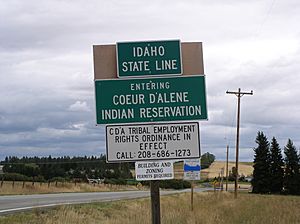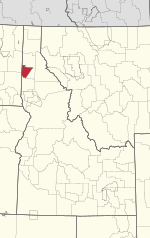Coeur d'Alene Reservation facts for kids
Quick facts for kids
Coeur d'Alene Reservation
|
|
|---|---|

Entrance sign
|
|

Location of Coeur d'Alene Reservation
|
|
| Tribe | Coeur d'Alene |
| Country | United States |
| State | Idaho |
| County | Benewah County and Kootenai County |
| Area | |
| • Total | 1,356.531 km2 (523.760 sq mi) |
| Website | Coeur d'Alene Tribe |
The Coeur d'Alene Reservation is a special area of land in northwestern Idaho, United States. It is the home of the Coeur d'Alene people, a Native American tribe. This tribe is one of five tribes officially recognized by the government in Idaho.
The reservation is located in parts of Benewah and Kootenai counties. Its total land area is about 524 square miles (1,356 square kilometers). In 2000, about 6,551 people lived there. The biggest town completely inside the reservation is Plummer. More than 1,000 people lived there in 2010. A part of the city of St. Maries also extends onto the reservation.
Contents
History of the Coeur d'Alene Tribe
The Coeur d'Alene Reservation is a place "where the old ones walked." The tribe used the land's resources for fishing and hunting. French fur traders gave the tribe the name "Coeur d'Alene." This means "Heart of the Awl." They gave this name because the tribe was very skilled at trading.
The United States gained the Coeur d'Alene territory in 1846. Many settlers from the eastern U.S. then moved into the area. After a conflict called the Skitswish War in 1858, more people came. This was because silver was found nearby in 1863. Large amounts of silver were discovered through mining.
In 1873, President Ulysses S. Grant officially recognized the reservation. This decision, made by executive order, greatly reduced the tribe's land. The land became about 940 square miles (2,400 square kilometers). The tribe's chief, Peter Mocetelme, disagreed with this. He even met with President Grant about it. The plan was to sell one-third of the original Coeur d'Alene land to other settlers.
By 1885, the tribe had not received official approval or payment for their land. The tribe tried again to get Congress's attention. They wanted an official peace treaty. Over time, new boundaries were set, including on Lake Coeur d'Alene. This made the reservation even smaller, about 539 square miles (1,400 square kilometers).
Land disagreements continued for many years. In 1997, the U.S. Supreme Court decided that the Coeur d'Alene tribe could not claim Lake Coeur d'Alene. Another similar case in 2001 also ruled against the tribe.
Geography and Nature
The Coeur d'Alene people and nearby tribes once lived on a huge area. This land covered parts of eastern Washington, northern Idaho, and western Montana. It was over 3.5 million acres (20,234 square kilometers). This region had many different natural areas. These included forested mountains, marshes, and lakes.
The Coeur d'Alene tribe's reservation is in northern Idaho. It is south of Bonner County and west of Shoshone County. It also borders Washington state to the east of Spokane Valley. Lake Coeur d'Alene is right in the middle of the reservation.
The tribe traditionally hunted and fished for many types of fish. These included cutthroat trout, salmon, and steelhead. Cutthroat trout were once caught in the St. Joe River and Lake Coeur d'Alene. Today, these trout are mostly found only in the Coeur d'Alene Basin.
Coeur d'Alene People
Today, there are over 2,190 members of the Coeur d'Alene people. They are known for being a "non-nomadic" tribe. This means they stayed in one place instead of moving around a lot. Since 1947, the Coeur d'Alene tribe has had leaders. These leaders oversee important issues within the tribe.
The tribal council includes a chairman, a vice-chairman, and a secretary-treasurer. There are also several other council members. The chairman and vice-chairman often work with the federal government.
Economy and Trading
Trading was very important to the Coeur d'Alene people. A French fur trader once called them "the greatest traders in the world." The land provided many resources. This allowed the tribe to stay in one place. They could also set up farms and grow crops. Fish, animals, waterfowl, nuts, and berries were all found nearby. These came from the lakes, mountains, and wetlands.
The Coeur d'Alene tribe can earn money through businesses. All their business plans and land leases must be approved. The tribe's main ways of earning money are farming and gaming. They employ about 1,000 people in these areas. The tribe grows several crops on a 6,000-acre farm. They also have land for growing grass (turf farming) and for logging.
For gaming, the tribe runs the Coeur d'Alene Casino, Resort, and Hotel. This business earns about $20 million in profit each year. The Coeur d'Alene tribe is also involved in other businesses. These include an automotive center, a hardware store, food markets, and a medical center.
Communities
- Conkling Park
- DeSmet
- Harrison (part, population 267 persons)
- Parkline
- Plummer
- Rockford Bay
- St. Maries (part, population 734 persons)
- Tensed
- Worley
Notable residents

